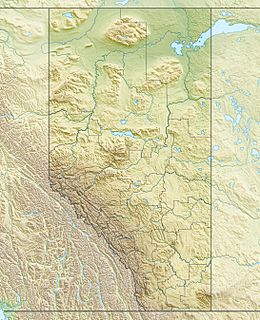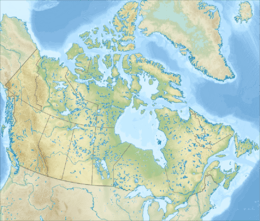Monarch Mountain (Alberta) facts for kids
Quick facts for kids Monarch Mountain |
|
|---|---|

Monarch Mountain seen from The Whistlers
|
|
| Highest point | |
| Elevation | 2,777 m (9,111 ft) |
| Prominence | 577 m (1,893 ft) |
| Geography | |
| Location | Jasper National Park Alberta, Canada |
| Parent range | Victoria Cross Ranges Canadian Rockies |
| Topo map | NTS 83E/01 |
Monarch Mountain is a tall mountain in Jasper National Park, Alberta, Canada. It stands about 2,777 meters (9,111 feet) high. This makes it a very impressive peak in the Victoria Cross Ranges, which are part of the larger Canadian Rockies. No one knows for sure how Monarch Mountain got its name.
Water from the mountain flows into nearby rivers. Rain and melting snow from Monarch Mountain drain into smaller streams. These streams then join the Miette River and Snaring River. Both of these rivers eventually flow into the big Athabasca River.
Contents
What is the Climate Like?
The weather at Monarch Mountain is quite cold. It has what scientists call a subarctic climate. This means winters are very cold and snowy. Summers are usually mild, not too hot.
Winter Weather
In winter, temperatures can drop below −20 °C (–4 °F). With the wind blowing, it can feel even colder, sometimes below −30 °C (–22 °F). This is called the wind chill factor.
Best Time to Visit
If you want to explore the mountain, the best time to go is from July through September. The weather is usually nicer then, making it safer and more fun for outdoor activities.
How Was Monarch Mountain Formed?
Monarch Mountain is made of sedimentary rock. This type of rock forms when layers of sand, mud, and tiny bits of plants and animals settle over millions of years. These layers get pressed together and harden into rock.
Ancient Rock Layers
The rocks in Monarch Mountain were laid down a very long time ago. This happened during periods known as the Precambrian and Jurassic times. The Precambrian period was billions of years ago, and the Jurassic period was when dinosaurs roamed the Earth.
Mountain Building
Later, a huge event called the Laramide orogeny happened. This was a time when massive forces deep within the Earth pushed and folded the land. This pushing caused the rock layers of Monarch Mountain to lift up. They were pushed east and even moved over younger rock layers, creating the tall mountain we see today.



